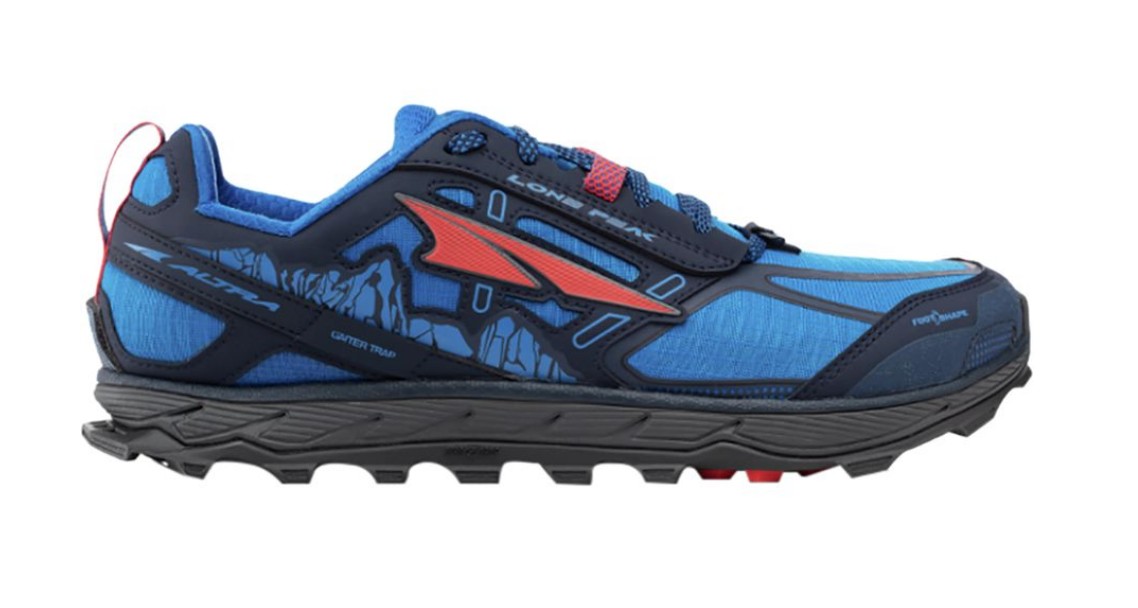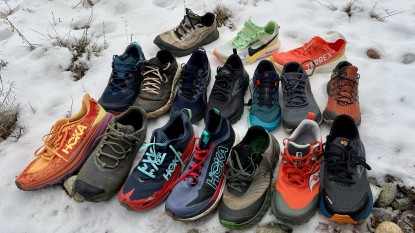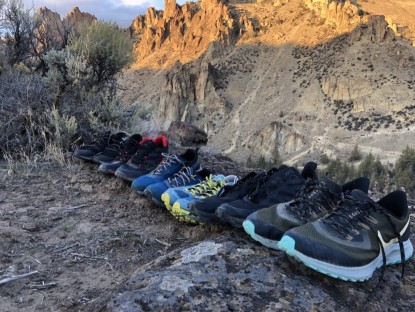Altra Lone Peak 4.0 Review
Our Verdict
Our Analysis and Test Results
The Lone Peak 4 is Altra's moderately cushioned trail shoe, with the Altra Superior 4 and King MT having less cushioning, and the Timp and Olympus providing more underfoot protection. Compared to year's past, the Lone Peak 4 has less foam, some of which has been replaced by a StoneGuard rock shield. While the overall effect of this is more trail feel and less absorption of blows to the feet, there is a noticeable positive payoff when it comes to stability, responsiveness, and sensitivity. In this shoe, your foot feels closer to the ground and minimized is the bounciness of the foam in old versions, and also thankfully the feeling of “dead shoes” that came when the foam quickly compressed out.
Also updated is the amount of padding on the inside of the shoe, which has been drastically reduced. The fit of the forefoot is now wider and longer, and the upper material has been switched to a thinner ripstop nylon with less overlays and reinforcement. This shoe does not feel as sweaty and hot as the 3.5 and went from being very poor in our water bucket testing to performing near the top. It retains the four-point gaiter trap system for use with Altra's gaiters, which we recommend due to the low cut around the ankle. Lastly, the outsole design is updated to a more aggressive pattern, but the rubber remains the same. Overall, this shoe now fits very similar to the Superior 4, but is still thicker, stiffer, more protective, and heavier underfoot.
Foot Protection
The midsole of the Lone Peak 4 is a sandwich of EVA foam and their A-bound foam compound, with a StoneGuard in there somewhere as well. Runners that are familiar with the Altra Superior 4 will know all about the StoneGuard rock shield, as in that shoe it comes as an optional insert one can slide under the insole. That is not the case with the Lone Peak, as the StoneGuard is built into the shoe. The StoneGuard is a thin layer of rubbery plastic that takes the bite out of stepping on a sharp rock, but by no means absorbs or deflects the blow like a rock plate or steel shank. As such, the new design feels thinner, less cushioned, and less protective underfoot than older versions.
The upper is also a bit less protective than older versions, with a switch to thinner ripstop nylon and more thin TPU overlays. There are still a number of leather or synthetic leather overlays, but they mostly protect the sides of the foot and provide structure, leaving the critical wear areas on the sides of the forefoot and the crease point unprotected. The toe cap is a wide leather overlay that does not have any firm support, or bumper, integrated. Overall foot protection felt similar to the Saucony Peregrine ISO, but was on the lower end of the spectrum.
Traction
The outsole of this shoe is made up of Altra's Maxtrac rubber compound arranged into well-spaced, arrow-shaped lugs that are about 4mm deep, although in the arch of the foot, they are a bit deeper.
These lugs are situated in rows over the push-off point in the forefoot for greater traction, a design feature that Altra calls their “Trail Claw.” We find it to be a better design than the older version, which had small, hexagonal lugs.
The Maxtrac rubber is plenty grippy and sticky enough for most everyone. We think it grips dry rock well but does not by any means remain sticky on wet rock, a common problem for trail running shoes. Compared to the competition, the traction on this shoe performs about average, in line with that found on the Nike Air Zoom Wildhorse 5, but nowhere close to the amazing grip of the Salomon Speedcross 5.
Stability
The Lone Peak 4 is built on a zero-drop platform, meaning there is no difference between the height of the heel versus the toes. We find this tends to lead to a more stable shoe, especially when landing and traveling downhill. Additionally, this shoe is fairly wide throughout, especially in the forefoot, once again making for a stable landing platform. While 25mm of stack height (the amount of material between your foot and the ground), is not exactly a small number compared to the competition, it feels lower to the ground than plenty of other shoes we tested and lower than the old Lone Peak 3.5.
One problem when it comes to stability is that the shoe does not lock the foot in place super well and instead remains slightly sloppy. We actually liked this about it, as it retains a comfortable fit that doesn't pressure our feet anywhere but causes it to drop slightly in the stability department. In our testing, it wasn't quite as stable as the Nike Air Zoom Terra Kiger 5, but was rather pretty similar to the higher off the ground, but more snugly fitting Salomon S/Lab Ultra 2.
Comfort
One thing we love about this shoe is how comfortable it is. We have run in and tested at least eight different pairs of Altras over the last few years, and it would not be a stretch to call this the most refined and comfortable fit of any of them. That said, fit and comfort are fairly subjective and depend on the shape of each individual's foot, so take this advice as a recommendation and not as a guarantee.
The shoe fits fairly wide in the forefoot, allowing for the feet to actually splay out as Altra advertises, but which wasn't allowed well in the overly narrow older models. While still relatively wide in the midfoot and heel, we thought it is snug enough to keep our foot comfortably in place without too much slippage, even when running downhill. The length has increased so that the shoe now fits accurately to size (we have been recommending sizing up in Altras for years now). The mildly sloppy fit only adds to the comfort in our opinion, and makes it a better choice for hiking or running on non-technical trails at less than top speeds, but precludes it from being an ideal choice for speedy, technical mountain races.
For this edition, Altra changed the location and performance of their drainage vents, which are slightly reinforced perforated panels in the upper just above where it joins the midsole. In the toe, there are two holes cut out of the toe cap to allow for drainage as well. Whether due to these minor looking features, or a change in material choices, in our water bucket test, we noticed that the shoe went from being one of the most absorptive to one of the least in this newer edition. Those who run in very wet climates, like to plod through rivers without stopping, or have comically sweaty feet will rejoice. This shoe is similarly comfortable to the Inov-8 Roclite G 290 as well as the Superior 3.5.
Weight
Our size men's 11 US shoes tipped the scales at 23.9 ounces per pair straight out of the box. This was just over an ounce heavier than a pair of the 3.5s and ranks them among the heavier trail shoes in this review.
Presumably, the weight increase is due mostly to the inclusion of a larger StoneGuard replacing lightweight A-bound foam, because the entire construction of the upper looks to have shed weight, not gained it. In practice, these shoes don't feel super heavy or clunky while out for a run, so the weight isn't something we would be overly worried about. The super cush Hoka Speedgoat 3 weigh about the same amount, but the lightest shoe by far is the Hoka Evo Jawz.
Sensitivity
Like the Saucony Peregrine ISO, the Lone Peak 4 is one of those shoes that effectively balances underfoot protection with sensitivity, attributes that are typically at odds with each other. The Lone Peak is more sensitive than it is protective, providing great feeling and connection with the trail, while also offering some level of protection.
Runners who like a large amount of foam to protect them from the roots and rocks they encounter may be disappointed with the redesign of this shoe. Likewise, those who enjoy receiving a springy boost may also find something lacking. On the other hand, the performance of this shoe now feels far more genuine, authentic, and un-mediated compared with the formerly bouncy (until they weren't) Lone Peaks.
Best Applications
We enjoy this shoe best as a hiking shoe. Its heightened sensitivity and loose, comfortable fit, not to mention zero-drop platform, are all attributes that lend themselves well to comfortable walking. As a trail runner, we think it performs best on smoother, less technical trails, or as a comfortable shoe for collecting low-speed training miles.
Value
When it comes to price, this shoe is right about average for a trail runner these days. For the right purpose, we think this shoe offers pretty good value. While our shoes held up fine during our testing period, online customer reviews point to issues with durability that may shorten the life of the shoes, and thereby impact the perceived value.
Conclusion
The Altra Lone Peak 4 includes lots of fairly drastic updates to a shoe that seemed to have lost its way. After extensive testing, we feel that these updates, for the most part, positively impacted the performance and comfort of the shoe, and it has gone from one that we didn't want to wear, even though we love zero drops, to one that we now enjoy wearing a lot. We feel that longtime Altra wearers will, for the most part, be quite pleased with the Lone Peak 4, while first-timers will find a very comfortable zero drop shoe that is easy to love.















